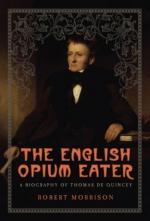|
This section contains 2,375 words (approx. 8 pages at 300 words per page) |

|
Seeing through the Eyes of an Opium-eater
Summary: Explores the history of opium and its use in 17th century Europe. Examines how Opium addiction often played a role in romantic literature. Discusses the effect of opium on the work of De Quincey.
Opium is a narcotic drug produced from the drying resin of unripe capsules of the opium poppy, Papaver Somniferum. The major constituent of opium is morphine, and these molecules have pain-killing properties similar to those of compounds called endorphins produced in the body. Several used it as a therapeutic drug to relieve depression, as well as physical pain. Opiates first produce a feeling of pleasure and euphoria, which is part of what is responsible for the psychological drive of certain people use this drug. By the 17th century, opium was used strictly for medication in Western Europe, but by the end of the 17th century, addiction became more widespread. At this time, the specific effects of opium on the human body and mind weren't exactly clear yet, but, if used continuously, the body demands larger amounts to reach the same sense of pleasure and can eventually lead to...
|
This section contains 2,375 words (approx. 8 pages at 300 words per page) |

|


